ICNC Monograph Series
The ICNC Research Monograph Series aims to connect research and practice. Drawing on scholarly literature and high quality analytical and empirical analyses equal to that of a serious academic publication, monographs aim to enrich public discourse by expanding scientific knowledge in the field of civil resistance and providing general and specific recommendations for practitioners such as activists, organizers, journalists, and members of INGOs and the policy community.
ICNC monographs:
- enrich scholarly understanding and knowledge of specific phenomena and case studies of civil resistance and nonviolent movements and campaigns;
- enhance the strategic practice of civil resistance by elaborating on a topic of relevance to activists and organizers;
- improve understanding of civil resistance by members of the policy and development community;
- provide insight into popular media coverage of civil resistance to improve media literacy and reporting by journalists;
- develop robust conceptual frameworks for understanding the nature, dynamics, power and impact of civil resistance movements.
Scholars as well as practitioners with expertise in the field of civil resistance are encouraged to apply and submit their proposals in response to the call. All monographs published from 2016 onward are peer-reviewed by at least two external reviewers.
Digital monograph copies are available free of charge on the ICNC website and print and e-book copies can be ordered on demand online via an international provider. We price monographs at-cost to maximize their availability and affordability.
The Editor of the ICNC Monograph Series is ICNC Advisor, Dr. Maciej Bartkowski.
To learn more about past monograph awardees, see recipients in 2017, 2016, 2015, and 2014.
Published Monographs
All Rise: Judicial Resistance in Poland
By Marcin Mrowicki
Publication Date: September 2024
Free Download (Print copy coming soon)
Purchase a Print Copy
 This monograph investigates the strategic and organized resistance of Polish judges against the authoritarian encroachments on judicial independence by the ruling Law and Justice (PiS) party from 2015 to 2023. Under the leadership of Jarosław Kaczyński, PiS systematically targeted key judicial institutions like the Constitutional Tribunal and the Supreme Court, implementing reforms to undermine judicial autonomy. This assault sparked an unprecedented resistance movement among Polish judges, who employed legal and extralegal tactics to defend the rule of law.
This monograph investigates the strategic and organized resistance of Polish judges against the authoritarian encroachments on judicial independence by the ruling Law and Justice (PiS) party from 2015 to 2023. Under the leadership of Jarosław Kaczyński, PiS systematically targeted key judicial institutions like the Constitutional Tribunal and the Supreme Court, implementing reforms to undermine judicial autonomy. This assault sparked an unprecedented resistance movement among Polish judges, who employed legal and extralegal tactics to defend the rule of law.
The resistance movement led to significant national and international outcomes, including presidential vetoes of controversial judicial reform bills, the reinstatement of judges, and actions by the Court of Justice of the European Union (CJEU) and the European Court of Human Rights (ECHR) against Poland. These efforts not only emphasized the importance of judicial independence as a cornerstone of democracy but also provided a powerful example for other nations facing similar authoritarian threats.
Through interviews with key judicial and legal figures, the monograph offers a comprehensive account of the motivations, actions, and consequences of judicial resistance in Poland. Furthermore, it catalogs the judges’ many actions according to Michael Beer’s framework of tactics from Civil Resistance Tactics in the 21st Century. Herein are valuable insights into the role of the judiciary in defending democracy, with broader implications for prodemocracy movements worldwide.
Prison Hunger Strikes in Palestine: A Strategic Perspective
By Malaka Shwaikh & Rebecca Ruth Gould
Publication Date: January 2023
Free Download
Purchase a Print Copy
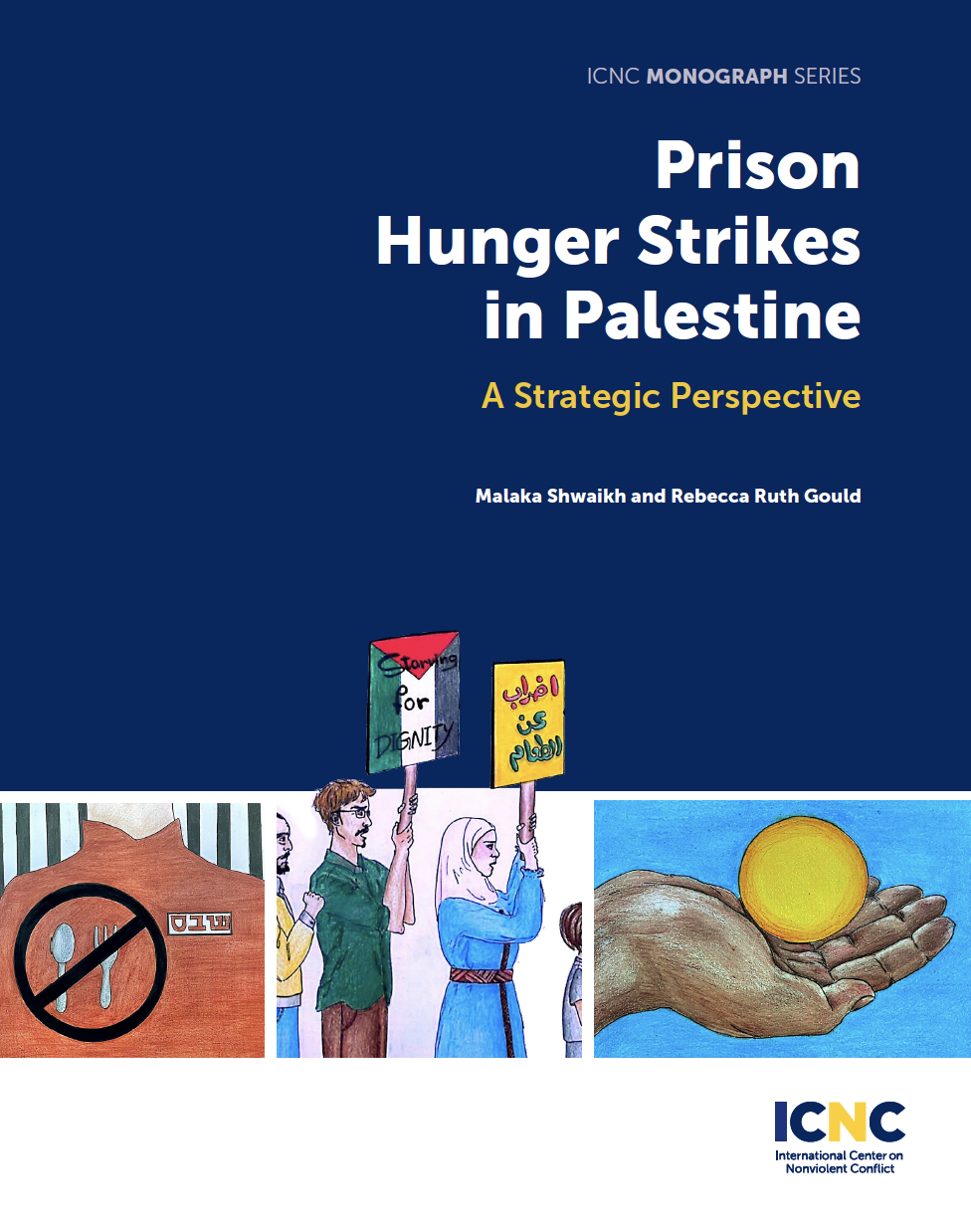 This publication is the first major transnational examination of prison hunger strikes. While focusing on Palestine, the research is enriched by extensive interviews and conversations with South African, Kurdish, Irish, and British ex-prisoners and hunger strikers. This study reveals in unprecedented detail how prison hunger strikes achieve monumental feats of resistance through the weaponization of lives.
This publication is the first major transnational examination of prison hunger strikes. While focusing on Palestine, the research is enriched by extensive interviews and conversations with South African, Kurdish, Irish, and British ex-prisoners and hunger strikers. This study reveals in unprecedented detail how prison hunger strikes achieve monumental feats of resistance through the weaponization of lives.
How do prison hunger strikers achieve demands? How do they stay connected with the outside world in a space that is designed to cut them off from that world? And why would a prisoner put their lives at risk by refusing to eat or, at times, drink? This research shows that sometimes prisoners’ need for dignity (karamah) and freedom (hurriya) trump their hunger pangs and thirst.
Prison Hunger Strikes in Palestine evaluates the process of hunger striking, including the repressive actions prisoners encounter, and the negotiation process. It analyzes differences and similarities between individual and collective strikes, and evaluates the role and impact of solidarity actions from outside the prison walls.
The work’s critical and grassroots understanding of prison hunger strikes fully centers the voices of hunger strikers. The analysis results in actionable takeaways that will be as useful to prison activists as they will be to their allies around the world.
Resource Mobilization in Palestinian Nonviolent Campaigns
By: Mahmoud Soliman
Date of Publication: August 2022
Free Download
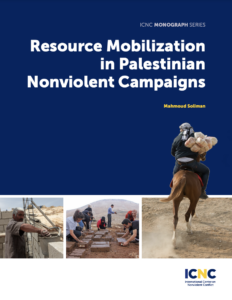 This monograph analyzes how Palestinian grassroots activists, popular resistance committees (PRCs), and popular resistance networks (PRNs) secured, managed, and used material and non-material resources to wage sustained and successful nonviolent campaigns in Area C of the occupied West Bank.
This monograph analyzes how Palestinian grassroots activists, popular resistance committees (PRCs), and popular resistance networks (PRNs) secured, managed, and used material and non-material resources to wage sustained and successful nonviolent campaigns in Area C of the occupied West Bank.
A comprehensive analytical framework is developed to capture a variety of resources and to better understand the role that different types of resources have in the launching, conducting, and outcomes of a campaign. This framework is then used to analyze three nonviolent campaigns led by Palestinian communities living under occupation, highlighting how the Palestinian activists managed to secure, administer, and deploy a diverse range of material and non-material resources to support their campaigns.
This study offers specific recommendations and lessons learned from the investigated cases for various actors—including activists, allies that want to support grassroots campaigns, and researchers interested in furthering the study of the role and impact of resources in nonviolent organizing and their successful acquisition by local organizers.
Civil Resistance Against Climate Change
By: Robyn Gulliver, Kelly Fielding, and Winnifred Louis
Date of Publication: September 2021
Free Download
Purchase a Print Copy
Purchase an e-book (Nook | Kindle)
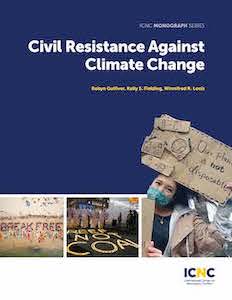
Transnational movements using nonviolent resistance tactics to demand action on climate change have emerged from a foundation of decades of persistent and diverse environmental activism. What are the features of this nonviolent resistance that differentiate it from previous activism? What response is this resistance prompting from political and financial entities? To investigate these questions this monograph combines a large-scale longitudinal data set on climate activism in Australia with two case studies of nonviolent resistance against corporations.
The study offers key lessons for a range of individuals and groups, from climate activists and civil society organizations to academics and others interested in supporting nonviolent action against climate change. In doing so, it addresses major gaps in our understanding of the effectiveness of civil resistance against climate change and the potential this resistance holds to prompt urgent action.
The Impact of Nonviolent Resistance on the Peaceful Transformation of Civil War
By: Luke Abbs
Date of Publication: August 2021
Free Download
Purchase a Print Copy
Purchase an e-book (Nook | Kindle)
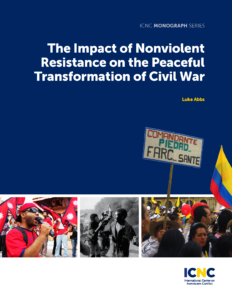 In recent years, a burgeoning literature has explored the strategic advantages of using nonviolent resistance to achieve positive political outcomes, such as regime change and democratization. Yet, despite one-fifth of large-scale nonviolent campaigns occurring during the course of a civil war, we know little about the affect nonviolent resistance might have on the transformation of armed conflict. Bringing together the previously isolated literatures on nonviolent resistance and peacebuilding, this manuscript explores how nonviolent resistance can aid peacebuilding efforts that transform ongoing armed conflict, using data on all civil wars episodes since 1945. The finding show nonviolent resistance does have a positive impact on the resolution of armed conflict, with evidence deriving from a Large-N statistical analysis, out-of-sample prediction and structured-focused case studies.
In recent years, a burgeoning literature has explored the strategic advantages of using nonviolent resistance to achieve positive political outcomes, such as regime change and democratization. Yet, despite one-fifth of large-scale nonviolent campaigns occurring during the course of a civil war, we know little about the affect nonviolent resistance might have on the transformation of armed conflict. Bringing together the previously isolated literatures on nonviolent resistance and peacebuilding, this manuscript explores how nonviolent resistance can aid peacebuilding efforts that transform ongoing armed conflict, using data on all civil wars episodes since 1945. The finding show nonviolent resistance does have a positive impact on the resolution of armed conflict, with evidence deriving from a Large-N statistical analysis, out-of-sample prediction and structured-focused case studies.
How Social Trust Shapes Civil Resistance: Lessons from Africa
By: Jacob S. Lewis
Date of Publication: August 2021
Free Download
Purchase a Print Copy
Purchase an e-book (Nook | Kindle)
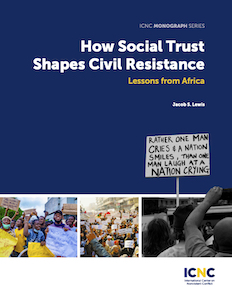
What role does trust play in shaping the outcomes of civil resistance campaigns? Trust has been found to be a critical factor in building political and social capital, encouraging group cohesion, and overcoming collective action problems. Despite this, trust has not been directly addressed by the civil resistance scholarship. This monograph addresses this lacuna by examining how trust shapes – and is shaped by – three levels of mobilization: trust at the individual level, trust within activist groups, and trust across resistance campaigns.
Nonviolent Movements and Material Resources in Northwest Mexico
By: Chris Allan and Scott DuPree
Date of Publication: June 2021
Free Download
Purchase a Print Copy
Purchase an e-book (Nook | Kindle)
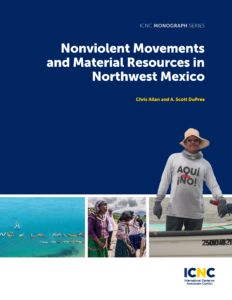 Nonviolent resistance movements operate with few resources and nearly no money. Yet these movements thrive and often succeed. The little external funding for civil society that is available rarely reaches the grassroots groups that are the backbone of these movements. How do they get the material resources they need? This study highlights strategies that are being used effectively by nonviolent movements to mobilize the resources they need to galvanize participation in movement actions and influence both the public and policymakers. Based on the experience of three campaigns in Northwest Mexico over two decades, the research finds that material resources are often mobilized internally in a decentralized way, driven by effective strategic planning and actions. We discuss the strategic choices nonviolent movements make to mobilize resources and how they direct them as situations change, and how outside supporters can provide resources in a constructive way.
Nonviolent resistance movements operate with few resources and nearly no money. Yet these movements thrive and often succeed. The little external funding for civil society that is available rarely reaches the grassroots groups that are the backbone of these movements. How do they get the material resources they need? This study highlights strategies that are being used effectively by nonviolent movements to mobilize the resources they need to galvanize participation in movement actions and influence both the public and policymakers. Based on the experience of three campaigns in Northwest Mexico over two decades, the research finds that material resources are often mobilized internally in a decentralized way, driven by effective strategic planning and actions. We discuss the strategic choices nonviolent movements make to mobilize resources and how they direct them as situations change, and how outside supporters can provide resources in a constructive way.
Civil Resistance Tactics in the 21st Century
By Michael Beer
Date of Publication: March 2021
Free Download: English | Farsi | Spanish
Purchase a Print Copy
Purchase e-book (Nook | Kindle)
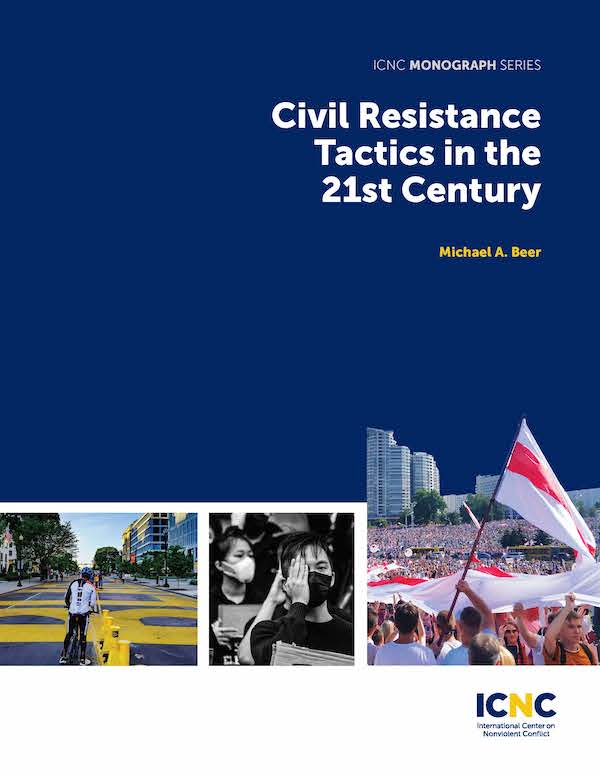 This monograph adds new methods of nonviolent action to the classic list of 198 methods categorized by Gene Sharp in 1973 in his book, The Methods of Nonviolent Action. This monograph maintains that nonviolent action encompasses a large category of human activity and that new and old tactics are employed daily. It also analyzes strengths and weaknesses of Dr. Sharp’s typologies, proposes helpful new categories of nonviolent action, and documents additional methods of nonviolent action and new scholarship from the fields of civil resistance, human rights defense, and social change.
This monograph adds new methods of nonviolent action to the classic list of 198 methods categorized by Gene Sharp in 1973 in his book, The Methods of Nonviolent Action. This monograph maintains that nonviolent action encompasses a large category of human activity and that new and old tactics are employed daily. It also analyzes strengths and weaknesses of Dr. Sharp’s typologies, proposes helpful new categories of nonviolent action, and documents additional methods of nonviolent action and new scholarship from the fields of civil resistance, human rights defense, and social change.
The monograph concludes with a summary of lessons learned and how they are relevant for practitioners, educators, and scholars of civil resistance. Recommendations are made for further application and research.
The Role of External Support in Nonviolent Campaigns: Poisoned Chalice or Holy Grail?
By: Erica Chenoweth & Maria J. Stephan
Date of Publication: February 2021
Free Download
Purchase a Print Copy
Purchase e-book (Nook | Kindle)
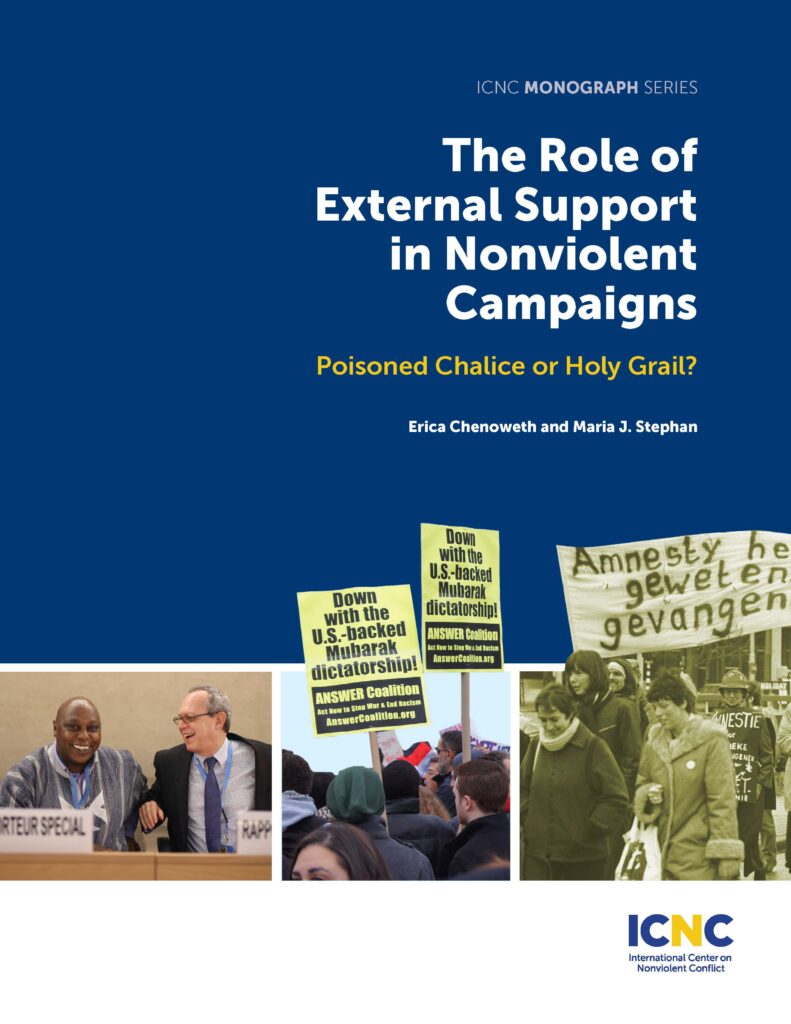 This monograph draws from an ICNC-sponsored multi-year research project that examines the effects of different forms of external aid on the outcomes and longer-term impacts of civil resistance campaigns. Very little research has systematically investigated the impacts of external support on the effectiveness of nonviolent resistance. Existing research reaches somewhat contradictory conclusions, with some finding that external support for nonviolent campaigns is harmful, that external support is sometimes helpful, or that external support has little observable effect. This study will assess different types of external – material and non-material – assistance to civil resistance movements offered by state ad non-state actors at different stages of civil resistance: pre, during and post-conflict periods. Finally, it will evaluate the impact of the specific type of aid, its timing and provisions by different actors on the overall trajectories of civil resistance campaigns and their outcomes.
This monograph draws from an ICNC-sponsored multi-year research project that examines the effects of different forms of external aid on the outcomes and longer-term impacts of civil resistance campaigns. Very little research has systematically investigated the impacts of external support on the effectiveness of nonviolent resistance. Existing research reaches somewhat contradictory conclusions, with some finding that external support for nonviolent campaigns is harmful, that external support is sometimes helpful, or that external support has little observable effect. This study will assess different types of external – material and non-material – assistance to civil resistance movements offered by state ad non-state actors at different stages of civil resistance: pre, during and post-conflict periods. Finally, it will evaluate the impact of the specific type of aid, its timing and provisions by different actors on the overall trajectories of civil resistance campaigns and their outcomes.
When Civil Resistance Succeeds: Building Democracy After Popular Nonviolent Uprisings
By: Jonathan Pinckney
Date of publication: October 2018
Free Download
Purchase a Print Copy
Purchase e-book (Nook | Kindle)
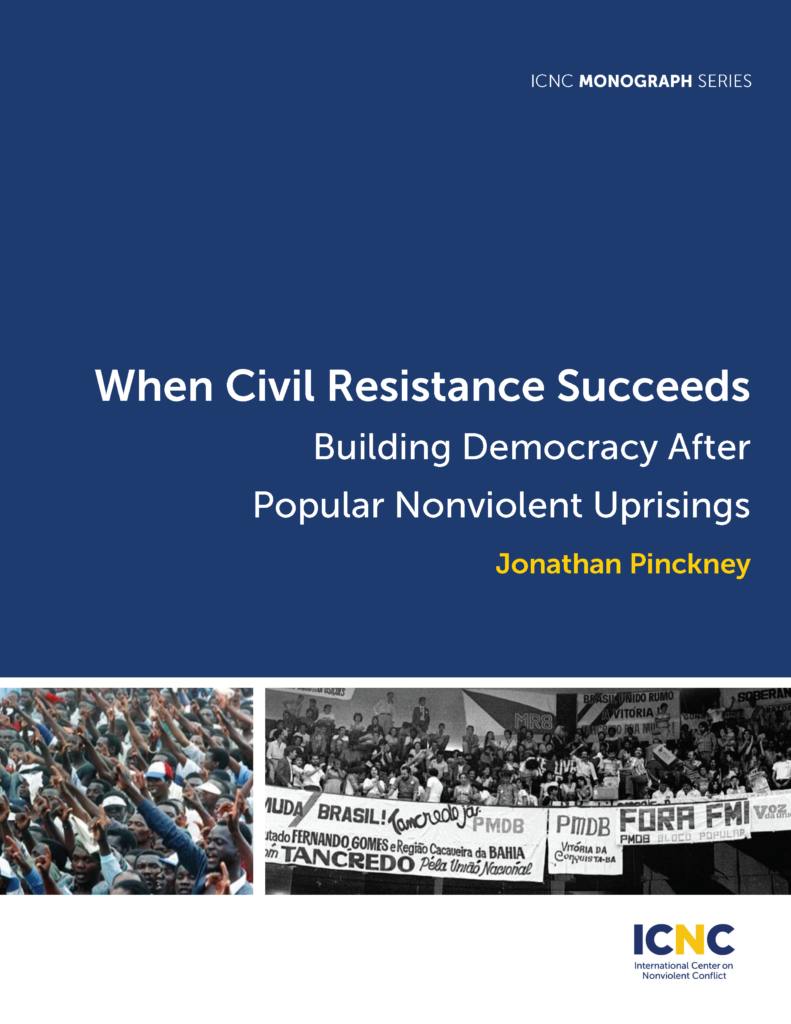 Why do some nonviolent revolutions lead to successful democratization while others fail to consolidate democratic change? And what can activists do to push toward a victory over dictatorship that results in long-term political freedom?
Why do some nonviolent revolutions lead to successful democratization while others fail to consolidate democratic change? And what can activists do to push toward a victory over dictatorship that results in long-term political freedom?
Several studies show that nonviolent revolutions are generally a more positive force for democratization than violent revolutions and top-down political transitions. However, some nonviolent revolutions, such as the Arab Spring revolution in Egypt, do not seem to fi t this pattern. This study takes on this puzzle and reveals that the answer lies in large part in the actions of civil society prior to and during transition. Democracy is most likely when activists can keep their social bases mobilized for positive political change while directing that mobilization toward building new political institutions.
Civil Resistance Against Coups: A Comparative and Historical Perspective
By: Stephen Zunes
Date of publication: December 2017
Free Download: English | Thai
Purchase a Print Copy
Purchase e-book (Nook | Kindle)
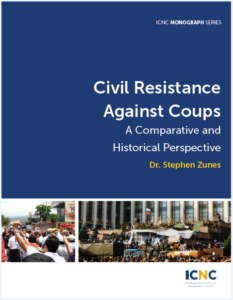 Nations are not helpless if the military decides to stage a coup. On dozens of occasions in recent decades, even in the face of intimidated political leaders and international indifference, civil society has risen up to challenge putschists through large-scale nonviolent direct action and noncooperation. How can an unarmed citizenry mobilize so quickly and defeat a powerful military committed to seizing control of the government? What accounts for the success or failure of nonviolent resistance movements to reverse coups and consolidate democratic gains?
Nations are not helpless if the military decides to stage a coup. On dozens of occasions in recent decades, even in the face of intimidated political leaders and international indifference, civil society has risen up to challenge putschists through large-scale nonviolent direct action and noncooperation. How can an unarmed citizenry mobilize so quickly and defeat a powerful military committed to seizing control of the government? What accounts for the success or failure of nonviolent resistance movements to reverse coups and consolidate democratic gains?
This monograph presents in-depth case studies and analysis intended to improve our understanding of the strategic utility of civil resistance against military takeovers; the nature of civil resistance mobilization against coups; and the role of civil resistance against coups in countries’ subsequent democratization efforts (or failure thereof). It offers key lessons for pro-democracy activists and societies vulnerable to military usurpation of power; national civilian and military bureaucracies; external state and non-state agencies supportive of democracy; and future scholarship on this subject.
People Power Movements and International Human Rights: Creating a Legal Framework
By: Elizabeth A. Wilson
Date of publication: August 2017
Revised: July 2019
Free Download
Purchase a Print Copy
Purchase e-book (Nook | Kindle)
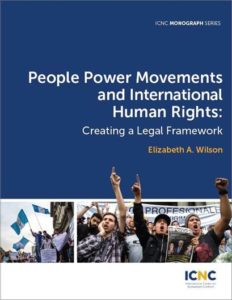 International human rights law did not come into existence top-down, out of the benevolent intentions of states, even though states eventually began to recognize that large-scale human rights abuses could pose a threat to the international order. Rather, it came into existence from the bottom-up efforts of ordinary people in civil society to ally with each other in solidarity and demand their rights, often through organized nonviolent campaigns and movements that pressured elites and powerholders to recognize or grant individual rights (freedom for slaves, women’s rights, labor rights, and children’s rights, to name a few). Unlike international law generally, the real source of international human rights law has been the coordinated, organized and nonviolently forceful efforts of individuals—in other words, what one can refer to as people power.
International human rights law did not come into existence top-down, out of the benevolent intentions of states, even though states eventually began to recognize that large-scale human rights abuses could pose a threat to the international order. Rather, it came into existence from the bottom-up efforts of ordinary people in civil society to ally with each other in solidarity and demand their rights, often through organized nonviolent campaigns and movements that pressured elites and powerholders to recognize or grant individual rights (freedom for slaves, women’s rights, labor rights, and children’s rights, to name a few). Unlike international law generally, the real source of international human rights law has been the coordinated, organized and nonviolently forceful efforts of individuals—in other words, what one can refer to as people power.
Making or Breaking Nonviolent Discipline in Civil Resistance Movements
By: Jonathan Pinckney
Date of publication: October 2016
Free Download: English | Chinese | Summary of findings in Farsi
Purchase a Print Copy
Purchase e-book (Nook | Kindle)
How can we understand when nonviolent movements will stay nonviolent? When are they likely to break down into violence? In this  monograph, Jonathan Pinckney analyzes what promotes and undermines nonviolent discipline in civil resistance movements. Combining quantitative research on thousands of nonviolent and violent actions with a detailed comparison of three relevant case studies of civil resistance during the “Color Revolutions,” Pinckney’s analysis provides important lessons for activists and organizers on the front lines, as well as for practitioners whose work may impact the outcomes of nonviolent struggles. We learn how repression consistently induces violence, as do government concessions. On the flip side, we see that structuring a campaign in an inclusive and non-hierarchical way is conducive to greater nonviolent discipline.
monograph, Jonathan Pinckney analyzes what promotes and undermines nonviolent discipline in civil resistance movements. Combining quantitative research on thousands of nonviolent and violent actions with a detailed comparison of three relevant case studies of civil resistance during the “Color Revolutions,” Pinckney’s analysis provides important lessons for activists and organizers on the front lines, as well as for practitioners whose work may impact the outcomes of nonviolent struggles. We learn how repression consistently induces violence, as do government concessions. On the flip side, we see that structuring a campaign in an inclusive and non-hierarchical way is conducive to greater nonviolent discipline.
The Tibetan Nonviolent Struggle: A Strategic and Historical Analysis
 By: Tenzin Dorjee
By: Tenzin Dorjee
Date of publication: September 2015
Free Download: English | Tibetan
Purchase a Print Copy
Purchase e-book (Nook | Kindle)
Contrary to a perception — fueled by Chinese propaganda during the 2008 Tibetan uprising that the Tibetan struggle is heading toward extremism, this study shows that the movement has since the 1950s moved toward a tighter embrace of nonviolent resistance. The study traces this evolution, analyzing the central themes, purposes, challenges, strategies, tactics and impacts of three major Tibetan uprisings over the past six decades.
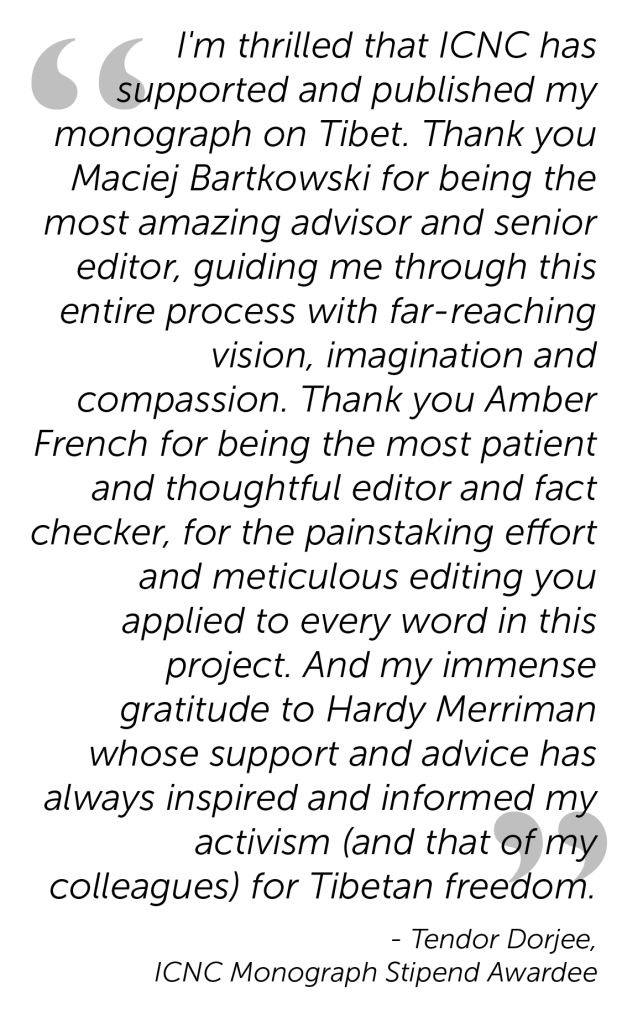
Tibetans are now waging a quiet, slow-building nonviolent movement, centered on strengthening the Tibetan national and cultural fabric via what the author refers to as transformative resistance. This is happening in an immensely repressive political environment, which shows that there is a way to mobilize people power against even one of the most ruthless regimes in the world.
The Power of Staying Put: Nonviolent Resistance Against Armed Groups in Colombia
By: Juan Masullo
Date of publication: August 2015
Free Download: English | Spanish (select chapters)
Purchase a Print Copy
Purchase e-book (Nook | Kindle)
 Confronted with civil war, local civilians typically either collaborate with the strongest actor in town or flee the area. Yet civilians are not stuck inexorably within this dichotomous choice. Collectively defying armed groups by engaging in organized nonviolent forms of noncooperation, self-organization and disruption is another option. This monograph explores this option through sustained and organized civil resistance led by ordinary peasants against state and non-state repressive actors in Colombia’s longstanding civil war: the case of the Peace Community of San José de Apartadó.
Confronted with civil war, local civilians typically either collaborate with the strongest actor in town or flee the area. Yet civilians are not stuck inexorably within this dichotomous choice. Collectively defying armed groups by engaging in organized nonviolent forms of noncooperation, self-organization and disruption is another option. This monograph explores this option through sustained and organized civil resistance led by ordinary peasants against state and non-state repressive actors in Colombia’s longstanding civil war: the case of the Peace Community of San José de Apartadó.
- Read Masullo’s article “Villagers stand up for peace in Colombia’s civil war”.
- Read “Campesinos colombianos que defienden la paz” (en español).
